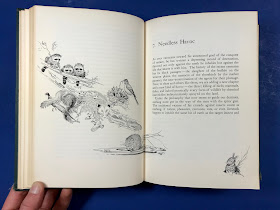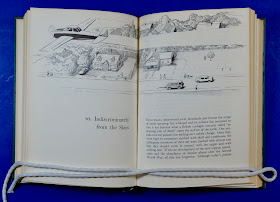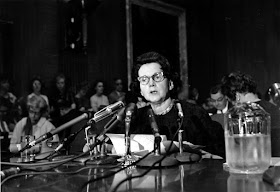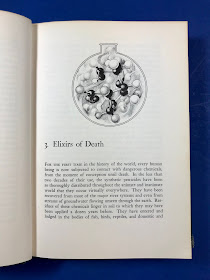 |
| Cover of the first edition of Silent Spring |
The book in question - the first edition of Rachel Carson’s Silent Spring, published in 1962, was revolutionary in how it translated complex chemical and ecological relationships into easily comprehensible arguments, its popularity, and its appeal to the general public. Due to a combination of these factors, Carson’s investigation of the potentially adverse impacts of widespread synthetic pesticide use - in agriculture and by the U.S. government in pest eradication programs - led to widespread concern about environmental and human health impacts, environmental policy change, and the emergence of the modern Environmental Movement. Today, Silent Spring continues to provide a valuable lesson about how we should interact with our fragile planet: proceed cautiously and think long-term
Prior to the publication of Silent Spring in late 1957, Rachel Carson was a distinguished marine biologist, author of the widely acclaimed novel The Sea Around Us, and the second woman hired by the U.S. Bureau of Fisheries (later the U.S. Fish & Wildlife Service). Through her friendships with fellow biologists, Carson closely followed a rising number of federal proposals for widespread pesticide spraying; including the United States Department of Agriculture's (USDA) plans to eradicate fire ants, gypsy moths, and other insects using chlorinated hydrocarbons and organophosphates. After nearly ten years of investigation and research, Carson published Silent Spring to raise environmental consciousness among the American public about what she saw as potentially dangerous synthetic pesticides, including the notorious substance known as DDT (Dichloro Diphenyl Trichloroethane). In the course of 250 pages, Carson translated ten years of ecological and chemical research into a narrative detailing how America’s addiction to pesticides would severely harm human health, the environment, and future generations’ ability to control increasingly resistant insect pests.
Amid the turmoil of the 1960s, USDA officials, farmers, and chemical-producing companies applauded the efficacy and safety of synthetic pesticides at killing insect pests. At a time when air, water, and soil pollution were mere afterthoughts in the minds of many industry leaders, Carson’s Silent Spring made two bold assertions; first, that synthetic pesticides like DDT could be carcinogenic and thus harmful to humans, and second, that chemicals like DDT can have huge negative environmental impacts, accumulating in the food chain until they interfere with biological processes and ecosystem functioning. In chapter 3 - famously titled “Elixirs of Death” - Carson presented considerable evidence for the toxicity of a wide array of synthetic pesticides, noting that “for the first time in the history of the world, every human being is now subjected to contact with dangerous chemicals... they occur virtually everywhere.” Although the chapter reads more like a gripping detective crime novel, Carson based her findings on research completed by National Cancer Institute researcher and environmental cancer section founding director Wilhelm Hueper, who had begun to classify many pesticides as carcinogenic - or cancer causing - for both animals and humans. With the help of her research assistant Jeanee David and NIH librarian Dorothy Algire, Carson found evidence to support the pesticide-cancer connection, much to the chagrin of chemical companies and many peers from the scientific community who reviewed Silent Spring. This finding was in sharp contrast to the general perception of chemicals like DDT at the time, which was sprayed readily across parks, beaches, and lawns to control mosquitoes, oftentimes while people were present. Later, in chapters titled “And No Birds Sing” and “Needless Havoc,” Carson reported that many synthetic pesticides readily accumulated in the environment, exponentially increasing in potency as animals lower in the food chain (i.e. fish) were consumed by animals higher in the food chain (i.e. eagles). Carson reported that this process - known as bioaccumulation - had significant negative impacts on many animals, most famously on birds. Carson discovered that birds ingesting DDT tended to lay thin-shelled eggs that would break prematurely, resulting in population declines of more than 80 percent. With continued use of synthetic pesticides like DDT, Carson predicted a grim future where birdsong would be largely absent - hence the title of her book.
 |
| Illustration from the opening page of chapter seven, highlighting the harmful impacts of chemical accumulation in food webs. |
Despite all the criticism, a growing body of scientific evidence has since supported Carson’s assertions. For example, in 2015, the International Agency for Research on Cancer classified DDT as a “probable carcinogen to humans”, with exposure leading to higher rates of both pancreatic and skin cancer. In addition, according to the EPA, “a relationship between DDT exposure and reproductive effects in humans is suspected.” Meanwhile, the detrimental impact of DDT on wildlife has also become evident through rebounding populations of previously endangered aquatic and avian species that Carson believed were negatively impacted by DDT. According to recent estimates, a ban on DDT and other pesticide reductions have allowed for the comeback of the bald eagle, peregrine falcon, brown pelican, and many other species once facing extinction in the contiguous United States. As a New York Times science article published on March 11th, 1982, described:
Since the ban (on DDT), the brown pelican, one of the most threatened species, has increased to an estimated 5,000 pairs along the Atlantic Coast, up from a low of about 1,100 to 1,200 breeding pairs in the 1960's. Ospreys, or fish hawks, had fallen to about 100 breeding pairs from 1,000 on the coastline between New York and Boston. Biologists are now hopeful the species will return to higher levels by the end of the century.As a growing body of evidence has since proven Carson’s premonitions, her call to proceed with caution in environmental matters, echoed throughout Silent Spring, becomes increasingly poignant. Carson encouraged Americans to question the logic of broadcasting potentially dangerous chemicals into the environment with little prior investigation of their environmental and health effects - but her powerful message, to question the indirect consequences of our actions on other organisms and future generations, extends well beyond pesticides. Were Carson alive today, she’d likely encourage us to approach practices in our everyday lives that we’ve accepted as “normal” - from industrial-scale cattle farming to ordering copious amounts of Amazon products - with a similar dose of caution and criticism. Silent Spring reminds us that only by proceeding cautiously and thinking about future generations, can we enact positive environmental change.
 |
| Opening illustration to Chapter 10 of Silent Spring. |
In addition to Carson’s engaging and approachable writing style and the sheer number of copies sold, Silent Spring was especially impactful due to the composition of the audience it reached. Silent Spring was particularly well-received by middle-class readers in addition to scientists and political elites, many of whom weren’t from traditional scientific backgrounds. As Carson said following the nomination of her work as the book-of-the-month, she hoped to "carry (Silent Spring) to farms and hamlets all over that country that don't know what a bookstore looks like—much less The New Yorker." Indeed, the book achieved something rare at the time; for a narrative based on ecological, chemical, and oncological research, it was read ravenously by farmers, small business owners, and Americans from various educational backgrounds across the U.S.
By prompting readers to confront their reliance on chemicals and by presenting them with the reality that their everyday habits might have unexpected consequences for future generations, organisms aside from pests, and their own health, Carson in turn provided a launchpad for Americans to be more critical of how they interacted with the environment on a daily basis. Silent Spring bolstered growing frustrations that young Americans felt toward governments and industries amid the Civil Rights Movement, the Vietnam War, and environmental catastrophes such as the massive 1969 oil spill in Santa Barbara, California, and channeled those feelings toward a mechanism for change (i.e. environmental policy). In doing so, Carson inadvertently fanned the flames for environmental action to spread like wildfire in areas beyond synthetic pesticides. Today, the founders of Earth Day recognize the large role that Silent Spring played in the establishment of their own environmental movement. As EarthDay.org notes, “the stage was set for change with the publication of Rachel Carson’s New York Times bestseller Silent Spring in 1962. The book represented a watershed moment as it raised public awareness and concern for living organisms, the environment and the inextricable links between pollution and public health.”
The paradigm shift in environmental thought started by the publication of Silent Spring had an enormous and measurable impact upon the environment and human health beginning in the 1960s. As readers began to concern themselves with the accumulation of potentially hazardous chemicals in the environment and in turn their own bodies, increasing pressure was placed on legislators, agrochemical companies, and landowners to enact change. The positive impacts of Silent Spring are perhaps best observed in the significant decline in the use of DDT-based pesticides in the United States following the book’s publication. As the U.S. Environmental Protection Agency (EPA) describes in their Brief History and Status of DTT publication:
The U.S. Department of Agriculture, the federal agency with responsibility for regulating pesticides before the formation of the U.S. Environmental Protection Agency in 1970, began regulatory actions in the 1960s to prohibit many of DDT's uses because of mounting evidence of the pesticide's declining benefits and environmental and toxicological effects. The publication in 1962 of Rachel Carson's Silent Spring stimulated widespread public concern over the dangers of improper pesticide use and the need for better pesticide controls.Indeed, Carson’s challenge - to not only consider the efficacy of pesticides in ridding of pests, but to critically examine the long-term and indirect impacts of chemicals before building agricultural systems reliant upon these substances - led to the establishment of the EPA and a subsequent ban on DDT’s agricultural use across the United States in 1972. After President John F. Kennedy read her book, Carson was called to testify before his Science Advisory Committee, which was in turn summoned to critically investigate DDT and other synthetic pesticides’ potential negative impacts.
 |
| Carson testifying before the Senate subcommittee. |
In conclusion, despite fierce opposition from chemical companies, Silent Spring inspired a generation to stand up for the health of the environment and helped ignite the modern Environmental Movement which continues today in the process. Following Silent Spring, those inspired by the text reversed federal pesticide policy, enacted a nationwide ban on DDT in agriculture, established the Environmental Protection Agency, and founded Earth Day. Silent Spring was revolutionary for condeming short-sighted tampering with the environment that was pervasive during the Cold War, challenging farmers, companies, consumers, and the U.S. government to consider the long-term side effects of their actions. Aside from Carson’s radical message, Silent Spring is a remarkable testament to the power of translating science in an engaging manner to diverse audiences, particularly those from non-scientific backgrounds. Without Silent Spring, and hence the ban on DDT and ensuing protections on many species, bald eagles and dozens of other bird species would have likely disappeared from the continental U.S., and humans would be facing higher rates of cancer and other adverse health effects.
Were Carson alive today (she passed in 1964), she’d be happy to learn about efforts that have been made to safeguard our waterways and species diversity, but she would also challenge us to go further. Today, Carson would reiterate Silent Spring’s timely lesson about how humans should interact with our fragile planet: we must proceed cautiously and think about long-term resilience. In an age where we’ve become increasingly aware of the myriad of ways in which chemical, biological, and sociocultural systems are interconnected, we must devote an adequate amount of time to science before committing ourselves to a single course of action, in order to understand the ramifications before it’s too late. In addition to proceeding with caution, we must be continually critical of established practices, in order to identify unintended consequences whose impacts couldn’t previously be measured. Just as Carson used animal trials and long-term observation to examine the true cost of our insatiable appetite for pesticides, we need to think of potential indirect effects and future impacts before committing ourselves to a singular course.
To read the first edition of Silent Spring for yourself, request "Depository SB959 .C3" the next time we're open!

No comments:
Post a Comment